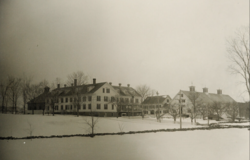Difference between revisions of "Belknap County Farm"
(Created page with "{{infobox institution | name = Belknap County Poor Farm | image = Belknap 1900.png | image_size = 250px | opened = 1872 | current_status = [[Demolished Institution|Demolished]...") |
(No difference)
|
Revision as of 08:36, 26 September 2023
| Belknap County Poor Farm | |
|---|---|
 | |
| Opened | 1872 |
| Current Status | Demolished |
| Building Style | Pre-1854 Plans |
| Location | Laconia, NH |
| Alternate Names |
|
History
The Belknap County Poor Farm was established in 1872 on 250 acres in Laconia. The Almshouse, jail, barns and necessary agricultural outbuildings were all built of wood. The farm would provide work for the able-bodied poor and prisoners.
The two-story almshouse provided shelter for the county’s poor as well as the superintendent and his family. A poorly built, two-story stone jail stood next door to the almshouse. The first floor housed prisoners, while those deemed “insane” lived on the second floor in cells or “strong rooms.” There were no living spaces or sitting rooms provided for the insane. All of the county’s insane population at this time were sent from the State Hospital at Concord.
By 1884, reports from the State Board of Health repeatedly called for proper housing for both prisoners and the insane. The jail was considered a “disgrace to civilization” as it had no ventilation, was overcrowded, and offered no separation of the sexes. Both prisoners and the insane were denied proper meals, clean water, and fresh air.
Two years later a new jail house was built on the county poor farm. This new brick structure was reinforced with railroad iron that would prevent anyone from escaping by breaking through the brick walls. The jail included 16 cells. At this time, an addition was put onto the Almshouse, providing two jail cells for female prisoners, two hospital rooms, and a large room to be used as a chapel and schoolroom. The new jail was connected to the almshouse by a covered walkway.
An 1889 report from the State Board of Health noted that there was still no separate ward for the county’s insane. The insane were allowed to mingle with the other inmates, “with the exception of one or two cases which are kept in confinement.” It had been suggested, again, that separate rooms or a separate wing be provided for the insane and that the “county at once provide better quarters for the detention of the violent insane.” The solution was to house the “demented insane” in three rooms in the attic of the almshouse. Again, the State Board of Health asked the county commissioners to erect a separate building for the insane. Their 1892 report noted “these [attic] rooms are not suitable for any class of the insane.”
By 1894, the insane were moved to an existing building on the poor farm that housed the laundry. They were forced to live in ten rooms fitted into the attic.
It seems that at some point between the 1894 report and a 1907 report stating that the insane had been moved to the State Hospital, a separate two-story brick building was erected to house the insane. There were eight rooms on the first floor, along with a separate bath and toilet rooms. The second floor also contained eight rooms.
The Almshouse in the early 1900s, however, was adequately designed to house and care for the county’s poor. Another wing had been added by this time. The east wing was for male inmates, while the west wing housed female inmates. On the first floor of the almshouse was the Superintendent’s sitting room, dining room, reception room, and office. Behind the Superintendent’s rooms was the female dining room. The Superintendent and his family lived on the second floor of the main building. On the first floor of the west wing was the male dining room, a few sleeping rooms, and a large smoking room. A piazza was added along the length of the wing. The majority of male inmates slept on the second floor. The female wing was laid out similarly. The kitchen, boiler room, and laundry were located in the basement. The building formerly used to house the insane now held prisoners in the basement, with the upper floors providing ample hospital rooms for the infirm.
By the 1960’s, the county began selling off parcels of the county farm. A more modern nursing facility and jail were built. While the original almshouse building no longer stands, parts of the 1890s brick jail are still in use by the current house of corrections.
A small county cemetery, called Primrose Cemetery, is located nearby the current Belknap County Nursing Home. The dates on the tombstones range from 1875-1891. The headstones are numbered, but little is known about who is buried at each plot.
- .Belknap back.png
Back of the Almshouse, showing two brick structures: Building for Insane (left) and House of Corrections (right), 1900.






